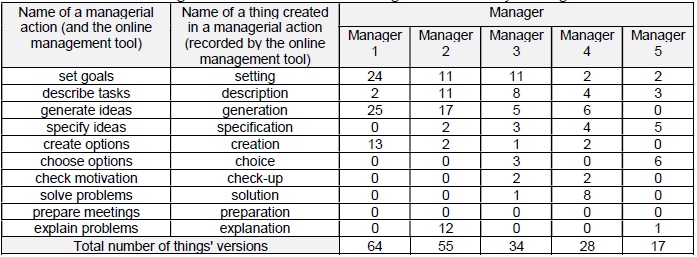An important question when constructing an artificial manager concerns what it is supposed to do. When I talk to management specialists, managers and programmers, the question is always asked about the purpose of such a machine. Sometimes the machine here just means software, and sometimes people imagine a figure that sits behind a desk and manages a team (most often dismissing subordinate people).
I wonder about this, too, which is why I have been doing research for several years aimed at finding out whether there are similarities between people who play the role of a manager. I am not so much interested in personal qualities or potential skills, but in the real managerial activities undertaken by such people. That’s why I organize studies that differ in details, but their main purpose is to investigate whether managers do the same thing when managing the same project.
At this point, I will return to my publication from the 29th EBES CONFERENCE, which was held in October 2019, but the publication did not appear until 2021. At that time I presented the results of a study on the similarity of the activities of the 5 managers participating in the study. It turned out that despite the fact that the managers prepared the same project, they did it completely differently!
First, it turned out that despite the fact that they all started and finished their work on the same day at roughly the same time, they worked with different intensity between these dates – the differences reached 150% of their working time.
Secondly, managers in preparing the project created a different number of objects such as goal, plan, motivation survey, brainstorming, etc. In the organizational size system, these objects are called primary organizational sizes. Their number of a given type is shown in Figure 1.

Figure 1. Number of objects produced by managers
Third, managers not only created different numbers of objects, but created them in different numbers of versions! This can be read from Figure 2. For example, Manager 1 created 2 goals (set goals in Figure 1), but did so in as many as 24 versions (set goals in Figure 2). That is, he changed these goals and kept changing them until he reached the end of the study. Manager 5, on the other hand, created only one goal (set goals in Figure 1) and changed it only once, since there are only 2 versions of this goal in Figure 2 for set goals.

Figure 2. Number of versions of objects produced by managers
What does this mean for designers of an artificial manager?
It turns out that it is impossible to build a universal artificial manager, because people behave so differently in the same situations that such an averaged artificial manager would not resemble any of the managers from whom it would learn its behavior.
It is impossible to build a universal artificial manager that would be “average.” But perhaps it would be possible to build an artificial manager that would be better than any of the people it learns from? Yes, it is possible. I will describe it in another post, and I have been using the solution for years in another field of research – the Competitiveness of Enterprises Barometer http://sensorium24.com/pl/
More you can read here:

